University Name: Control of Staphylococcus aureus in Food Industry
VerifiedAdded on 2022/10/18
|18
|5964
|205
Report
AI Summary
This report reviews strategies for controlling Staphylococcus aureus in the food industry. It begins by outlining the bacterium's characteristics, the risks associated with Staph food poisoning, and the importance of control measures. The methodology section details the literature review process, including the research question, search terms, and database selection. The report then explores various control strategies in meat, poultry, and dairy products. Specific strategies discussed include essential oils, edible films, and antimicrobial packaging. In meat, the use of essential oils, alginate films, and garlic extracts are highlighted. In poultry, the report focuses on essential oils and active packaging films. The report references numerous studies and concludes by summarizing the effectiveness of different approaches. The report emphasizes the need for continuous research and implementation of effective control strategies to minimize foodborne illnesses caused by Staphylococcus aureus.

Running head: MICROBIOLOGY
Control of Staphylococcus aureus in food industry
Name of the Student
Name of the University
Author Note
Control of Staphylococcus aureus in food industry
Name of the Student
Name of the University
Author Note
Paraphrase This Document
Need a fresh take? Get an instant paraphrase of this document with our AI Paraphraser
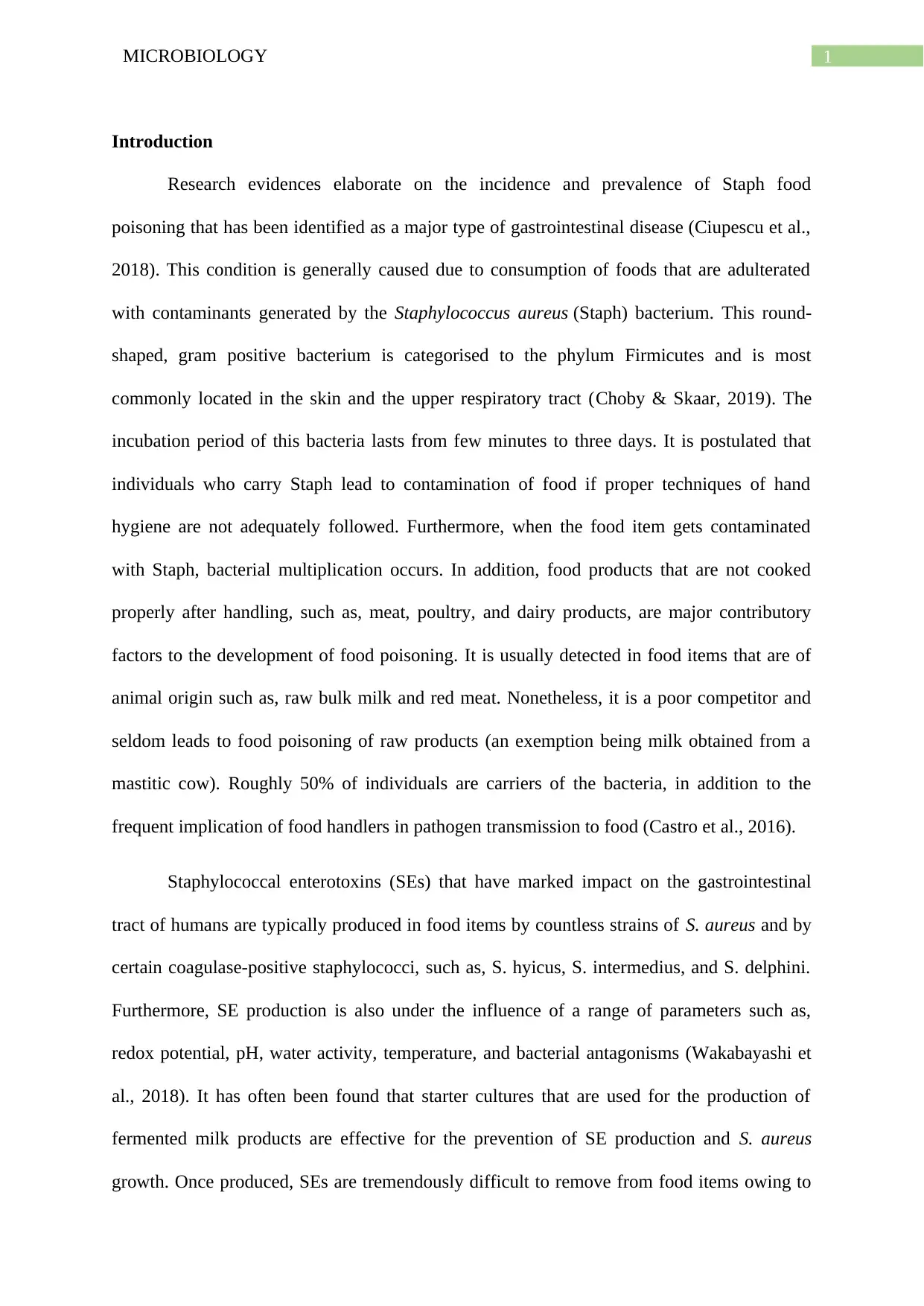
1MICROBIOLOGY
Introduction
Research evidences elaborate on the incidence and prevalence of Staph food
poisoning that has been identified as a major type of gastrointestinal disease (Ciupescu et al.,
2018). This condition is generally caused due to consumption of foods that are adulterated
with contaminants generated by the Staphylococcus aureus (Staph) bacterium. This round-
shaped, gram positive bacterium is categorised to the phylum Firmicutes and is most
commonly located in the skin and the upper respiratory tract (Choby & Skaar, 2019). The
incubation period of this bacteria lasts from few minutes to three days. It is postulated that
individuals who carry Staph lead to contamination of food if proper techniques of hand
hygiene are not adequately followed. Furthermore, when the food item gets contaminated
with Staph, bacterial multiplication occurs. In addition, food products that are not cooked
properly after handling, such as, meat, poultry, and dairy products, are major contributory
factors to the development of food poisoning. It is usually detected in food items that are of
animal origin such as, raw bulk milk and red meat. Nonetheless, it is a poor competitor and
seldom leads to food poisoning of raw products (an exemption being milk obtained from a
mastitic cow). Roughly 50% of individuals are carriers of the bacteria, in addition to the
frequent implication of food handlers in pathogen transmission to food (Castro et al., 2016).
Staphylococcal enterotoxins (SEs) that have marked impact on the gastrointestinal
tract of humans are typically produced in food items by countless strains of S. aureus and by
certain coagulase-positive staphylococci, such as, S. hyicus, S. intermedius, and S. delphini.
Furthermore, SE production is also under the influence of a range of parameters such as,
redox potential, pH, water activity, temperature, and bacterial antagonisms (Wakabayashi et
al., 2018). It has often been found that starter cultures that are used for the production of
fermented milk products are effective for the prevention of SE production and S. aureus
growth. Once produced, SEs are tremendously difficult to remove from food items owing to
Introduction
Research evidences elaborate on the incidence and prevalence of Staph food
poisoning that has been identified as a major type of gastrointestinal disease (Ciupescu et al.,
2018). This condition is generally caused due to consumption of foods that are adulterated
with contaminants generated by the Staphylococcus aureus (Staph) bacterium. This round-
shaped, gram positive bacterium is categorised to the phylum Firmicutes and is most
commonly located in the skin and the upper respiratory tract (Choby & Skaar, 2019). The
incubation period of this bacteria lasts from few minutes to three days. It is postulated that
individuals who carry Staph lead to contamination of food if proper techniques of hand
hygiene are not adequately followed. Furthermore, when the food item gets contaminated
with Staph, bacterial multiplication occurs. In addition, food products that are not cooked
properly after handling, such as, meat, poultry, and dairy products, are major contributory
factors to the development of food poisoning. It is usually detected in food items that are of
animal origin such as, raw bulk milk and red meat. Nonetheless, it is a poor competitor and
seldom leads to food poisoning of raw products (an exemption being milk obtained from a
mastitic cow). Roughly 50% of individuals are carriers of the bacteria, in addition to the
frequent implication of food handlers in pathogen transmission to food (Castro et al., 2016).
Staphylococcal enterotoxins (SEs) that have marked impact on the gastrointestinal
tract of humans are typically produced in food items by countless strains of S. aureus and by
certain coagulase-positive staphylococci, such as, S. hyicus, S. intermedius, and S. delphini.
Furthermore, SE production is also under the influence of a range of parameters such as,
redox potential, pH, water activity, temperature, and bacterial antagonisms (Wakabayashi et
al., 2018). It has often been found that starter cultures that are used for the production of
fermented milk products are effective for the prevention of SE production and S. aureus
growth. Once produced, SEs are tremendously difficult to remove from food items owing to
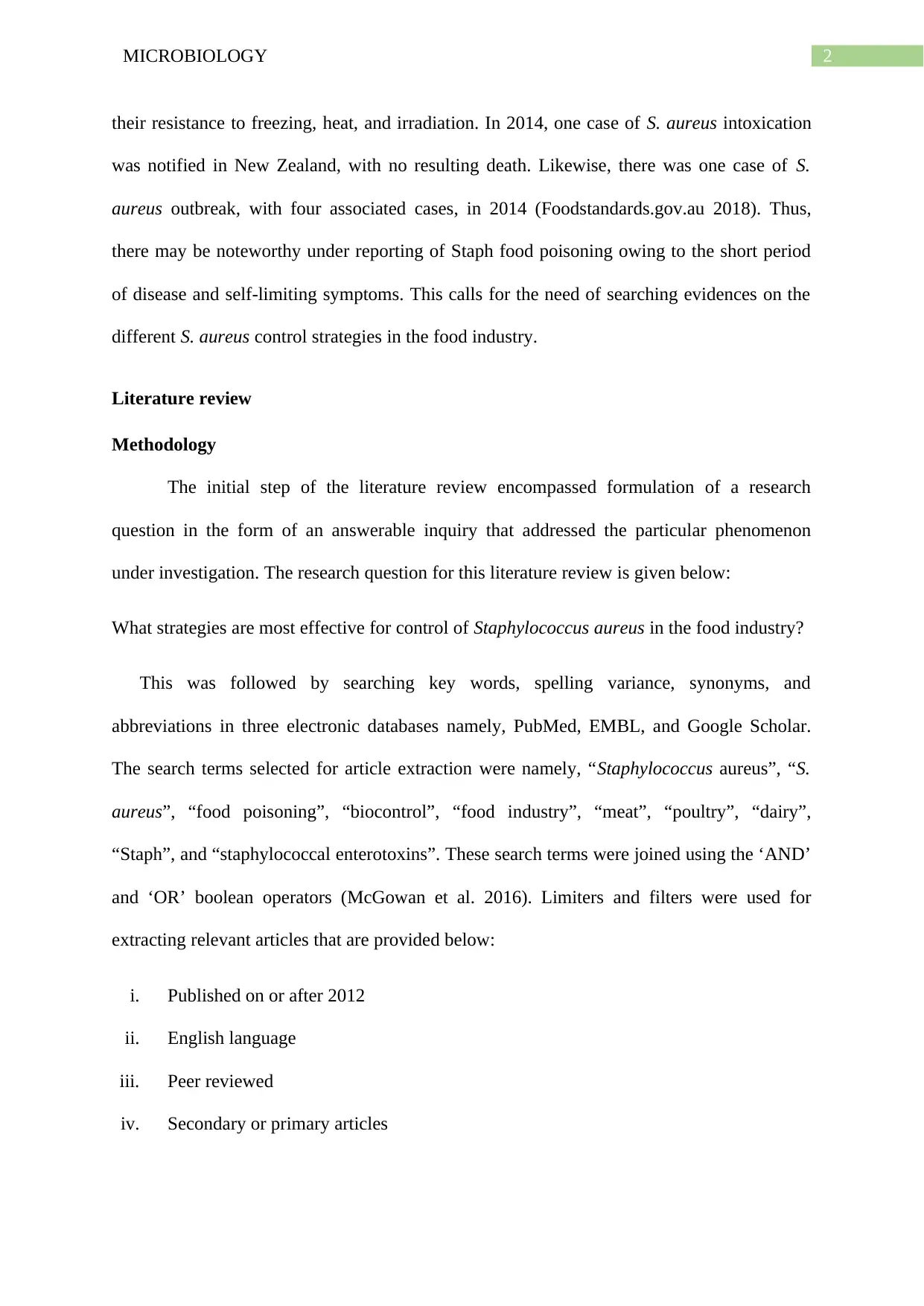
2MICROBIOLOGY
their resistance to freezing, heat, and irradiation. In 2014, one case of S. aureus intoxication
was notified in New Zealand, with no resulting death. Likewise, there was one case of S.
aureus outbreak, with four associated cases, in 2014 (Foodstandards.gov.au 2018). Thus,
there may be noteworthy under reporting of Staph food poisoning owing to the short period
of disease and self-limiting symptoms. This calls for the need of searching evidences on the
different S. aureus control strategies in the food industry.
Literature review
Methodology
The initial step of the literature review encompassed formulation of a research
question in the form of an answerable inquiry that addressed the particular phenomenon
under investigation. The research question for this literature review is given below:
What strategies are most effective for control of Staphylococcus aureus in the food industry?
This was followed by searching key words, spelling variance, synonyms, and
abbreviations in three electronic databases namely, PubMed, EMBL, and Google Scholar.
The search terms selected for article extraction were namely, “Staphylococcus aureus”, “S.
aureus”, “food poisoning”, “biocontrol”, “food industry”, “meat”, “poultry”, “dairy”,
“Staph”, and “staphylococcal enterotoxins”. These search terms were joined using the ‘AND’
and ‘OR’ boolean operators (McGowan et al. 2016). Limiters and filters were used for
extracting relevant articles that are provided below:
i. Published on or after 2012
ii. English language
iii. Peer reviewed
iv. Secondary or primary articles
their resistance to freezing, heat, and irradiation. In 2014, one case of S. aureus intoxication
was notified in New Zealand, with no resulting death. Likewise, there was one case of S.
aureus outbreak, with four associated cases, in 2014 (Foodstandards.gov.au 2018). Thus,
there may be noteworthy under reporting of Staph food poisoning owing to the short period
of disease and self-limiting symptoms. This calls for the need of searching evidences on the
different S. aureus control strategies in the food industry.
Literature review
Methodology
The initial step of the literature review encompassed formulation of a research
question in the form of an answerable inquiry that addressed the particular phenomenon
under investigation. The research question for this literature review is given below:
What strategies are most effective for control of Staphylococcus aureus in the food industry?
This was followed by searching key words, spelling variance, synonyms, and
abbreviations in three electronic databases namely, PubMed, EMBL, and Google Scholar.
The search terms selected for article extraction were namely, “Staphylococcus aureus”, “S.
aureus”, “food poisoning”, “biocontrol”, “food industry”, “meat”, “poultry”, “dairy”,
“Staph”, and “staphylococcal enterotoxins”. These search terms were joined using the ‘AND’
and ‘OR’ boolean operators (McGowan et al. 2016). Limiters and filters were used for
extracting relevant articles that are provided below:
i. Published on or after 2012
ii. English language
iii. Peer reviewed
iv. Secondary or primary articles
⊘ This is a preview!⊘
Do you want full access?
Subscribe today to unlock all pages.

Trusted by 1+ million students worldwide
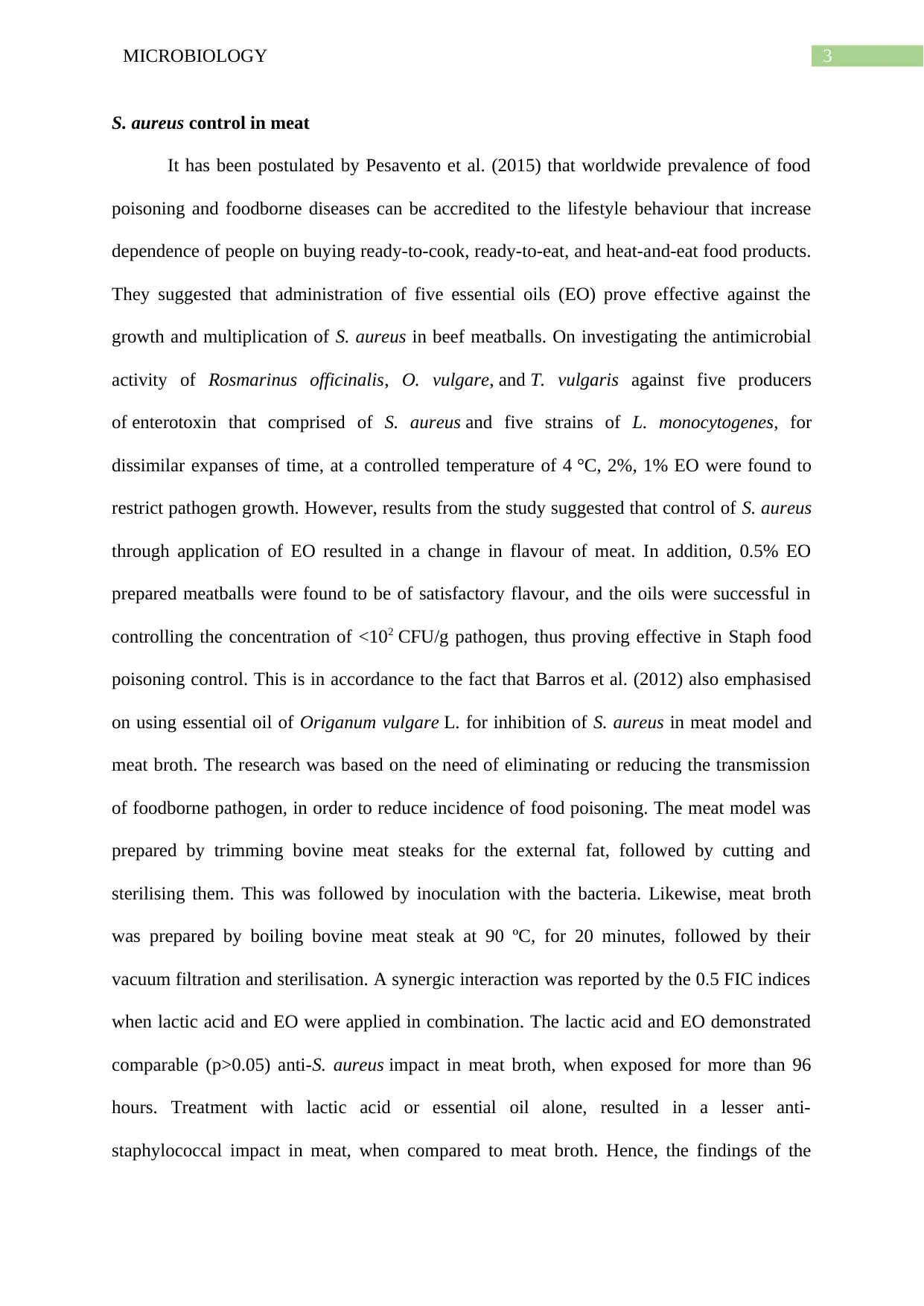
3MICROBIOLOGY
S. aureus control in meat
It has been postulated by Pesavento et al. (2015) that worldwide prevalence of food
poisoning and foodborne diseases can be accredited to the lifestyle behaviour that increase
dependence of people on buying ready-to-cook, ready-to-eat, and heat-and-eat food products.
They suggested that administration of five essential oils (EO) prove effective against the
growth and multiplication of S. aureus in beef meatballs. On investigating the antimicrobial
activity of Rosmarinus officinalis, O. vulgare, and T. vulgaris against five producers
of enterotoxin that comprised of S. aureus and five strains of L. monocytogenes, for
dissimilar expanses of time, at a controlled temperature of 4 °C, 2%, 1% EO were found to
restrict pathogen growth. However, results from the study suggested that control of S. aureus
through application of EO resulted in a change in flavour of meat. In addition, 0.5% EO
prepared meatballs were found to be of satisfactory flavour, and the oils were successful in
controlling the concentration of <102 CFU/g pathogen, thus proving effective in Staph food
poisoning control. This is in accordance to the fact that Barros et al. (2012) also emphasised
on using essential oil of Origanum vulgare L. for inhibition of S. aureus in meat model and
meat broth. The research was based on the need of eliminating or reducing the transmission
of foodborne pathogen, in order to reduce incidence of food poisoning. The meat model was
prepared by trimming bovine meat steaks for the external fat, followed by cutting and
sterilising them. This was followed by inoculation with the bacteria. Likewise, meat broth
was prepared by boiling bovine meat steak at 90 ºC, for 20 minutes, followed by their
vacuum filtration and sterilisation. A synergic interaction was reported by the 0.5 FIC indices
when lactic acid and EO were applied in combination. The lactic acid and EO demonstrated
comparable (p>0.05) anti-S. aureus impact in meat broth, when exposed for more than 96
hours. Treatment with lactic acid or essential oil alone, resulted in a lesser anti-
staphylococcal impact in meat, when compared to meat broth. Hence, the findings of the
S. aureus control in meat
It has been postulated by Pesavento et al. (2015) that worldwide prevalence of food
poisoning and foodborne diseases can be accredited to the lifestyle behaviour that increase
dependence of people on buying ready-to-cook, ready-to-eat, and heat-and-eat food products.
They suggested that administration of five essential oils (EO) prove effective against the
growth and multiplication of S. aureus in beef meatballs. On investigating the antimicrobial
activity of Rosmarinus officinalis, O. vulgare, and T. vulgaris against five producers
of enterotoxin that comprised of S. aureus and five strains of L. monocytogenes, for
dissimilar expanses of time, at a controlled temperature of 4 °C, 2%, 1% EO were found to
restrict pathogen growth. However, results from the study suggested that control of S. aureus
through application of EO resulted in a change in flavour of meat. In addition, 0.5% EO
prepared meatballs were found to be of satisfactory flavour, and the oils were successful in
controlling the concentration of <102 CFU/g pathogen, thus proving effective in Staph food
poisoning control. This is in accordance to the fact that Barros et al. (2012) also emphasised
on using essential oil of Origanum vulgare L. for inhibition of S. aureus in meat model and
meat broth. The research was based on the need of eliminating or reducing the transmission
of foodborne pathogen, in order to reduce incidence of food poisoning. The meat model was
prepared by trimming bovine meat steaks for the external fat, followed by cutting and
sterilising them. This was followed by inoculation with the bacteria. Likewise, meat broth
was prepared by boiling bovine meat steak at 90 ºC, for 20 minutes, followed by their
vacuum filtration and sterilisation. A synergic interaction was reported by the 0.5 FIC indices
when lactic acid and EO were applied in combination. The lactic acid and EO demonstrated
comparable (p>0.05) anti-S. aureus impact in meat broth, when exposed for more than 96
hours. Treatment with lactic acid or essential oil alone, resulted in a lesser anti-
staphylococcal impact in meat, when compared to meat broth. Hence, the findings of the
Paraphrase This Document
Need a fresh take? Get an instant paraphrase of this document with our AI Paraphraser
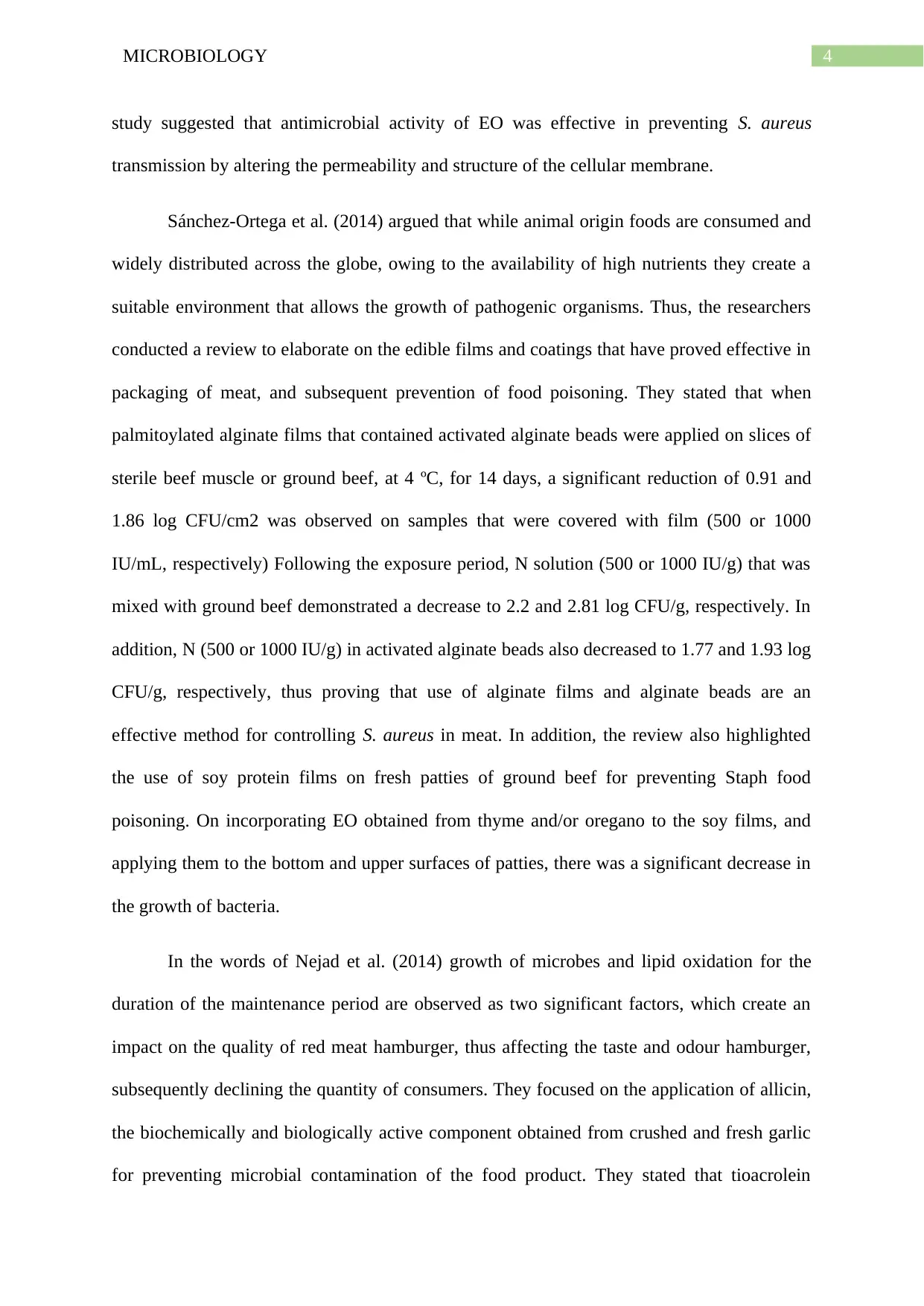
4MICROBIOLOGY
study suggested that antimicrobial activity of EO was effective in preventing S. aureus
transmission by altering the permeability and structure of the cellular membrane.
Sánchez-Ortega et al. (2014) argued that while animal origin foods are consumed and
widely distributed across the globe, owing to the availability of high nutrients they create a
suitable environment that allows the growth of pathogenic organisms. Thus, the researchers
conducted a review to elaborate on the edible films and coatings that have proved effective in
packaging of meat, and subsequent prevention of food poisoning. They stated that when
palmitoylated alginate films that contained activated alginate beads were applied on slices of
sterile beef muscle or ground beef, at 4 ºC, for 14 days, a significant reduction of 0.91 and
1.86 log CFU/cm2 was observed on samples that were covered with film (500 or 1000
IU/mL, respectively) Following the exposure period, N solution (500 or 1000 IU/g) that was
mixed with ground beef demonstrated a decrease to 2.2 and 2.81 log CFU/g, respectively. In
addition, N (500 or 1000 IU/g) in activated alginate beads also decreased to 1.77 and 1.93 log
CFU/g, respectively, thus proving that use of alginate films and alginate beads are an
effective method for controlling S. aureus in meat. In addition, the review also highlighted
the use of soy protein films on fresh patties of ground beef for preventing Staph food
poisoning. On incorporating EO obtained from thyme and/or oregano to the soy films, and
applying them to the bottom and upper surfaces of patties, there was a significant decrease in
the growth of bacteria.
In the words of Nejad et al. (2014) growth of microbes and lipid oxidation for the
duration of the maintenance period are observed as two significant factors, which create an
impact on the quality of red meat hamburger, thus affecting the taste and odour hamburger,
subsequently declining the quantity of consumers. They focused on the application of allicin,
the biochemically and biologically active component obtained from crushed and fresh garlic
for preventing microbial contamination of the food product. They stated that tioacrolein
study suggested that antimicrobial activity of EO was effective in preventing S. aureus
transmission by altering the permeability and structure of the cellular membrane.
Sánchez-Ortega et al. (2014) argued that while animal origin foods are consumed and
widely distributed across the globe, owing to the availability of high nutrients they create a
suitable environment that allows the growth of pathogenic organisms. Thus, the researchers
conducted a review to elaborate on the edible films and coatings that have proved effective in
packaging of meat, and subsequent prevention of food poisoning. They stated that when
palmitoylated alginate films that contained activated alginate beads were applied on slices of
sterile beef muscle or ground beef, at 4 ºC, for 14 days, a significant reduction of 0.91 and
1.86 log CFU/cm2 was observed on samples that were covered with film (500 or 1000
IU/mL, respectively) Following the exposure period, N solution (500 or 1000 IU/g) that was
mixed with ground beef demonstrated a decrease to 2.2 and 2.81 log CFU/g, respectively. In
addition, N (500 or 1000 IU/g) in activated alginate beads also decreased to 1.77 and 1.93 log
CFU/g, respectively, thus proving that use of alginate films and alginate beads are an
effective method for controlling S. aureus in meat. In addition, the review also highlighted
the use of soy protein films on fresh patties of ground beef for preventing Staph food
poisoning. On incorporating EO obtained from thyme and/or oregano to the soy films, and
applying them to the bottom and upper surfaces of patties, there was a significant decrease in
the growth of bacteria.
In the words of Nejad et al. (2014) growth of microbes and lipid oxidation for the
duration of the maintenance period are observed as two significant factors, which create an
impact on the quality of red meat hamburger, thus affecting the taste and odour hamburger,
subsequently declining the quantity of consumers. They focused on the application of allicin,
the biochemically and biologically active component obtained from crushed and fresh garlic
for preventing microbial contamination of the food product. They stated that tioacrolein
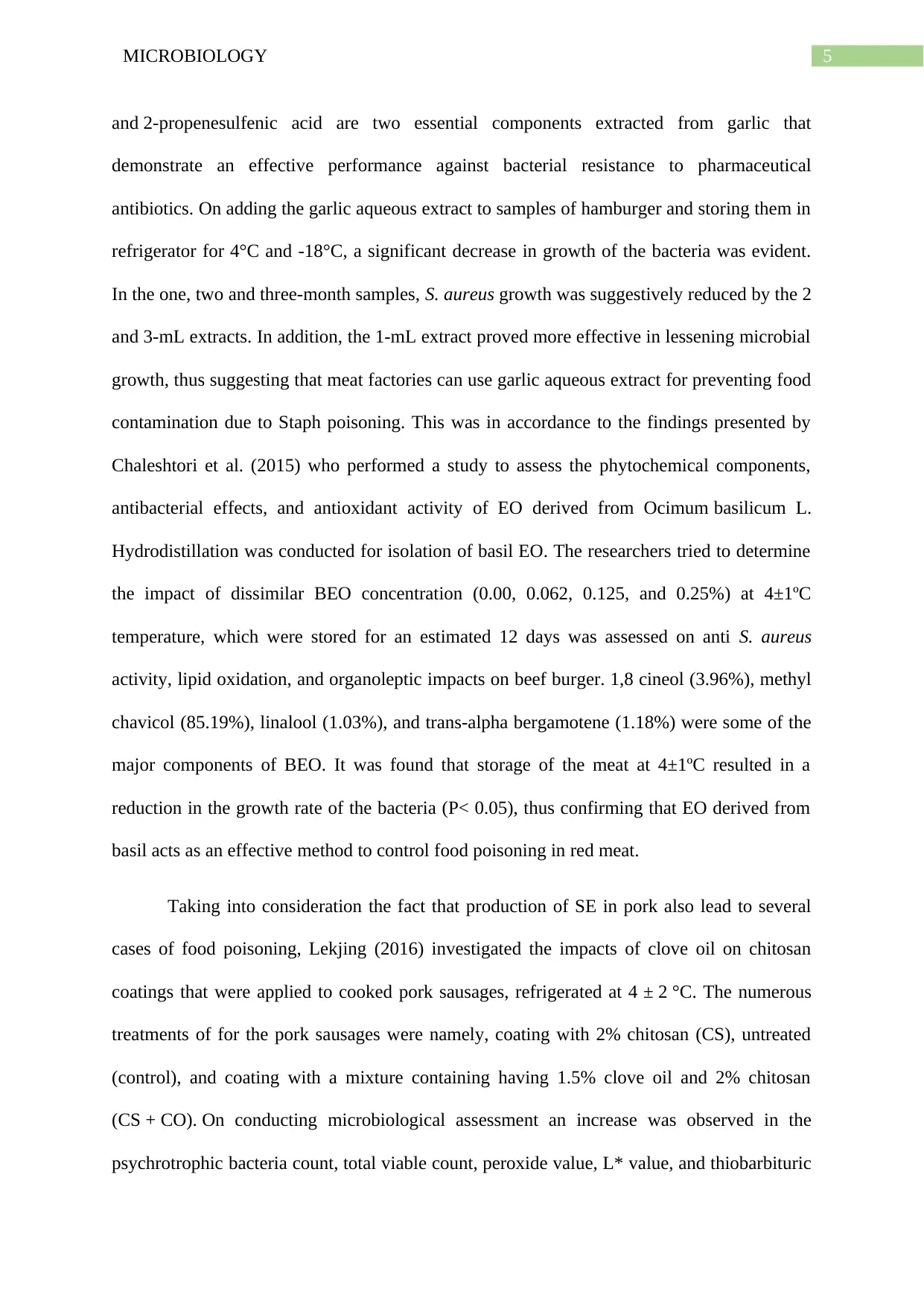
5MICROBIOLOGY
and 2-propenesulfenic acid are two essential components extracted from garlic that
demonstrate an effective performance against bacterial resistance to pharmaceutical
antibiotics. On adding the garlic aqueous extract to samples of hamburger and storing them in
refrigerator for 4°C and -18°C, a significant decrease in growth of the bacteria was evident.
In the one, two and three-month samples, S. aureus growth was suggestively reduced by the 2
and 3-mL extracts. In addition, the 1-mL extract proved more effective in lessening microbial
growth, thus suggesting that meat factories can use garlic aqueous extract for preventing food
contamination due to Staph poisoning. This was in accordance to the findings presented by
Chaleshtori et al. (2015) who performed a study to assess the phytochemical components,
antibacterial effects, and antioxidant activity of EO derived from Ocimum basilicum L.
Hydrodistillation was conducted for isolation of basil EO. The researchers tried to determine
the impact of dissimilar BEO concentration (0.00, 0.062, 0.125, and 0.25%) at 4±1ºC
temperature, which were stored for an estimated 12 days was assessed on anti S. aureus
activity, lipid oxidation, and organoleptic impacts on beef burger. 1,8 cineol (3.96%), methyl
chavicol (85.19%), linalool (1.03%), and trans-alpha bergamotene (1.18%) were some of the
major components of BEO. It was found that storage of the meat at 4±1ºC resulted in a
reduction in the growth rate of the bacteria (P< 0.05), thus confirming that EO derived from
basil acts as an effective method to control food poisoning in red meat.
Taking into consideration the fact that production of SE in pork also lead to several
cases of food poisoning, Lekjing (2016) investigated the impacts of clove oil on chitosan
coatings that were applied to cooked pork sausages, refrigerated at 4 ± 2 °C. The numerous
treatments of for the pork sausages were namely, coating with 2% chitosan (CS), untreated
(control), and coating with a mixture containing having 1.5% clove oil and 2% chitosan
(CS + CO). On conducting microbiological assessment an increase was observed in the
psychrotrophic bacteria count, total viable count, peroxide value, L* value, and thiobarbituric
and 2-propenesulfenic acid are two essential components extracted from garlic that
demonstrate an effective performance against bacterial resistance to pharmaceutical
antibiotics. On adding the garlic aqueous extract to samples of hamburger and storing them in
refrigerator for 4°C and -18°C, a significant decrease in growth of the bacteria was evident.
In the one, two and three-month samples, S. aureus growth was suggestively reduced by the 2
and 3-mL extracts. In addition, the 1-mL extract proved more effective in lessening microbial
growth, thus suggesting that meat factories can use garlic aqueous extract for preventing food
contamination due to Staph poisoning. This was in accordance to the findings presented by
Chaleshtori et al. (2015) who performed a study to assess the phytochemical components,
antibacterial effects, and antioxidant activity of EO derived from Ocimum basilicum L.
Hydrodistillation was conducted for isolation of basil EO. The researchers tried to determine
the impact of dissimilar BEO concentration (0.00, 0.062, 0.125, and 0.25%) at 4±1ºC
temperature, which were stored for an estimated 12 days was assessed on anti S. aureus
activity, lipid oxidation, and organoleptic impacts on beef burger. 1,8 cineol (3.96%), methyl
chavicol (85.19%), linalool (1.03%), and trans-alpha bergamotene (1.18%) were some of the
major components of BEO. It was found that storage of the meat at 4±1ºC resulted in a
reduction in the growth rate of the bacteria (P< 0.05), thus confirming that EO derived from
basil acts as an effective method to control food poisoning in red meat.
Taking into consideration the fact that production of SE in pork also lead to several
cases of food poisoning, Lekjing (2016) investigated the impacts of clove oil on chitosan
coatings that were applied to cooked pork sausages, refrigerated at 4 ± 2 °C. The numerous
treatments of for the pork sausages were namely, coating with 2% chitosan (CS), untreated
(control), and coating with a mixture containing having 1.5% clove oil and 2% chitosan
(CS + CO). On conducting microbiological assessment an increase was observed in the
psychrotrophic bacteria count, total viable count, peroxide value, L* value, and thiobarbituric
⊘ This is a preview!⊘
Do you want full access?
Subscribe today to unlock all pages.

Trusted by 1+ million students worldwide
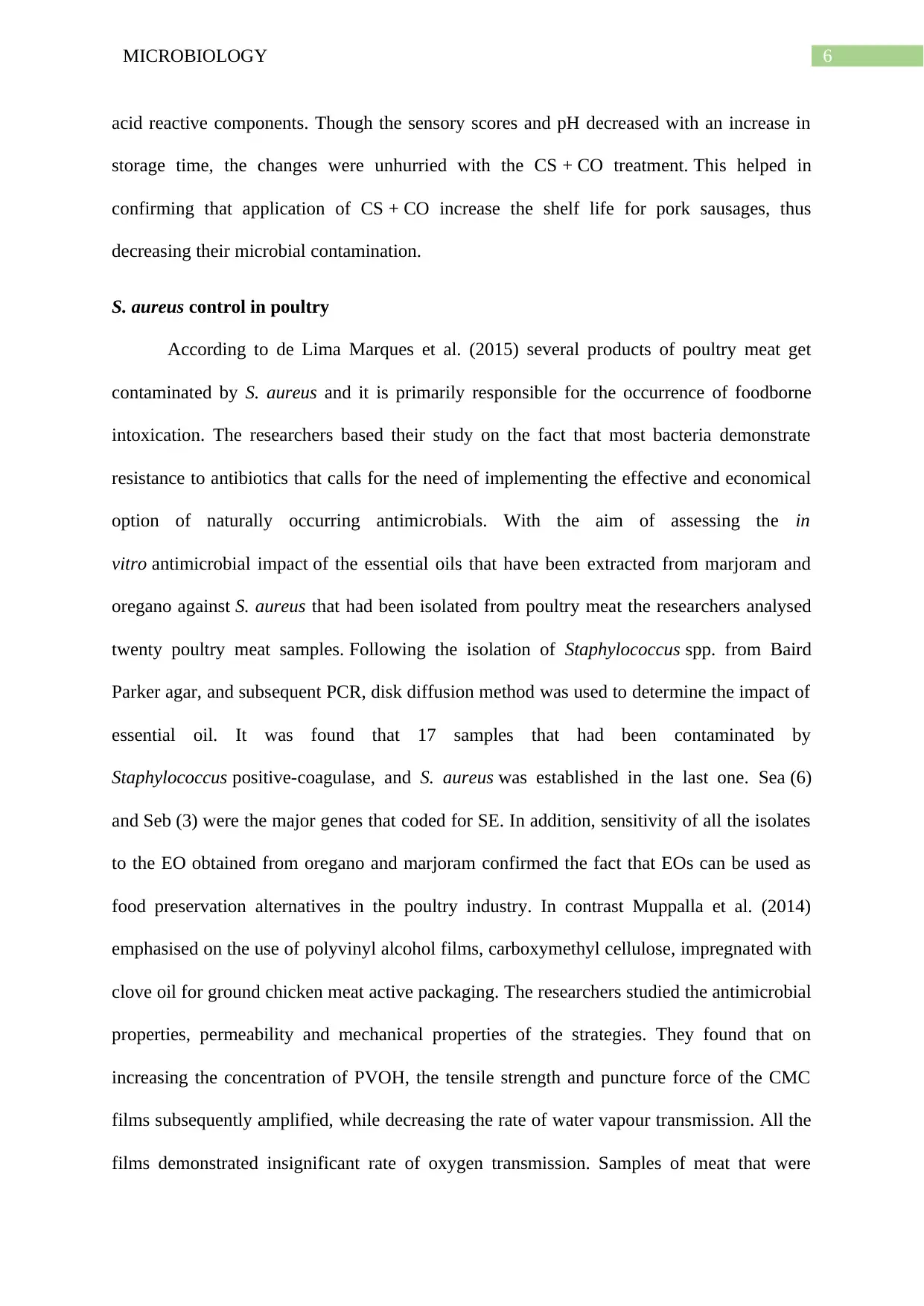
6MICROBIOLOGY
acid reactive components. Though the sensory scores and pH decreased with an increase in
storage time, the changes were unhurried with the CS + CO treatment. This helped in
confirming that application of CS + CO increase the shelf life for pork sausages, thus
decreasing their microbial contamination.
S. aureus control in poultry
According to de Lima Marques et al. (2015) several products of poultry meat get
contaminated by S. aureus and it is primarily responsible for the occurrence of foodborne
intoxication. The researchers based their study on the fact that most bacteria demonstrate
resistance to antibiotics that calls for the need of implementing the effective and economical
option of naturally occurring antimicrobials. With the aim of assessing the in
vitro antimicrobial impact of the essential oils that have been extracted from marjoram and
oregano against S. aureus that had been isolated from poultry meat the researchers analysed
twenty poultry meat samples. Following the isolation of Staphylococcus spp. from Baird
Parker agar, and subsequent PCR, disk diffusion method was used to determine the impact of
essential oil. It was found that 17 samples that had been contaminated by
Staphylococcus positive-coagulase, and S. aureus was established in the last one. Sea (6)
and Seb (3) were the major genes that coded for SE. In addition, sensitivity of all the isolates
to the EO obtained from oregano and marjoram confirmed the fact that EOs can be used as
food preservation alternatives in the poultry industry. In contrast Muppalla et al. (2014)
emphasised on the use of polyvinyl alcohol films, carboxymethyl cellulose, impregnated with
clove oil for ground chicken meat active packaging. The researchers studied the antimicrobial
properties, permeability and mechanical properties of the strategies. They found that on
increasing the concentration of PVOH, the tensile strength and puncture force of the CMC
films subsequently amplified, while decreasing the rate of water vapour transmission. All the
films demonstrated insignificant rate of oxygen transmission. Samples of meat that were
acid reactive components. Though the sensory scores and pH decreased with an increase in
storage time, the changes were unhurried with the CS + CO treatment. This helped in
confirming that application of CS + CO increase the shelf life for pork sausages, thus
decreasing their microbial contamination.
S. aureus control in poultry
According to de Lima Marques et al. (2015) several products of poultry meat get
contaminated by S. aureus and it is primarily responsible for the occurrence of foodborne
intoxication. The researchers based their study on the fact that most bacteria demonstrate
resistance to antibiotics that calls for the need of implementing the effective and economical
option of naturally occurring antimicrobials. With the aim of assessing the in
vitro antimicrobial impact of the essential oils that have been extracted from marjoram and
oregano against S. aureus that had been isolated from poultry meat the researchers analysed
twenty poultry meat samples. Following the isolation of Staphylococcus spp. from Baird
Parker agar, and subsequent PCR, disk diffusion method was used to determine the impact of
essential oil. It was found that 17 samples that had been contaminated by
Staphylococcus positive-coagulase, and S. aureus was established in the last one. Sea (6)
and Seb (3) were the major genes that coded for SE. In addition, sensitivity of all the isolates
to the EO obtained from oregano and marjoram confirmed the fact that EOs can be used as
food preservation alternatives in the poultry industry. In contrast Muppalla et al. (2014)
emphasised on the use of polyvinyl alcohol films, carboxymethyl cellulose, impregnated with
clove oil for ground chicken meat active packaging. The researchers studied the antimicrobial
properties, permeability and mechanical properties of the strategies. They found that on
increasing the concentration of PVOH, the tensile strength and puncture force of the CMC
films subsequently amplified, while decreasing the rate of water vapour transmission. All the
films demonstrated insignificant rate of oxygen transmission. Samples of meat that were
Paraphrase This Document
Need a fresh take? Get an instant paraphrase of this document with our AI Paraphraser
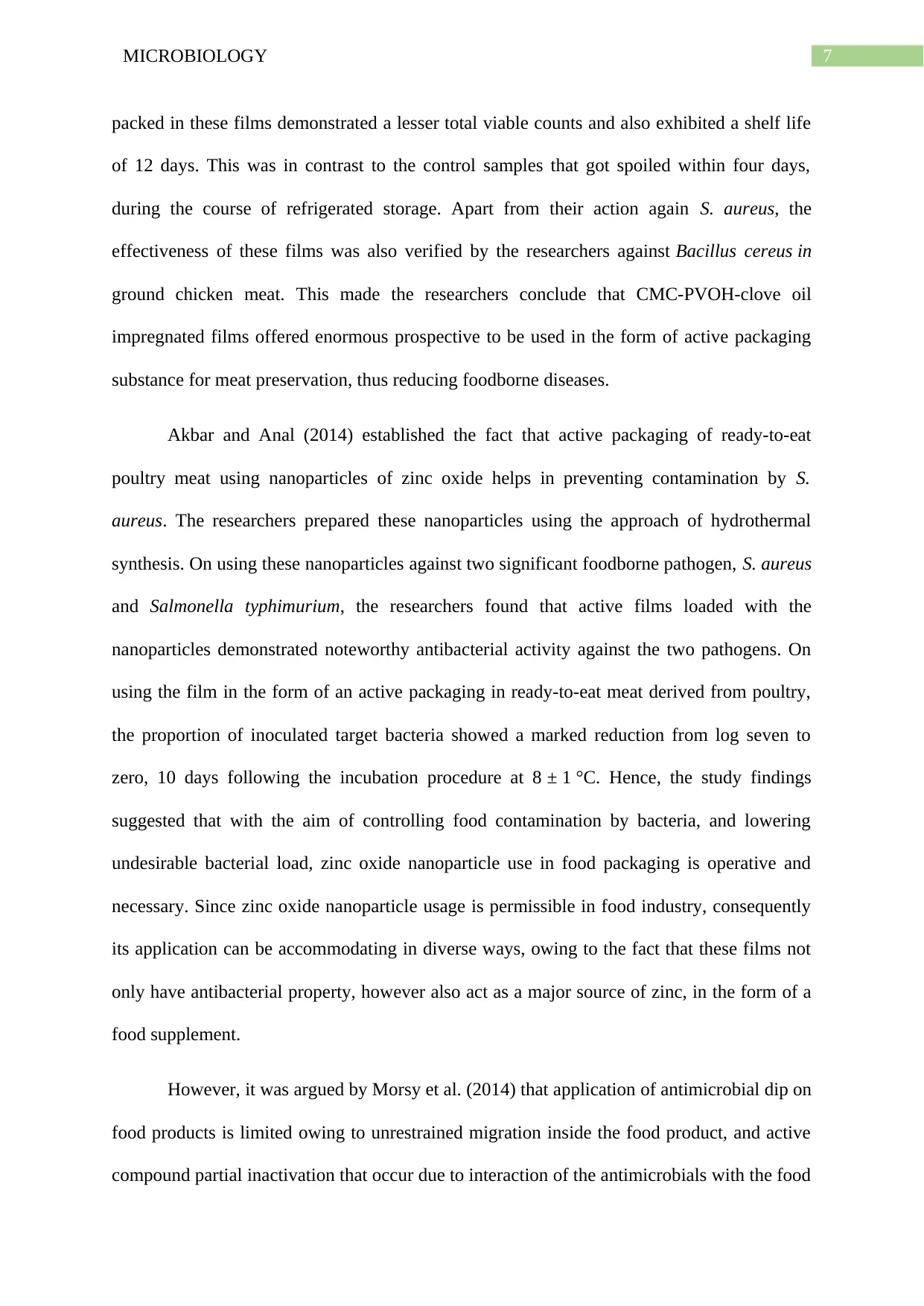
7MICROBIOLOGY
packed in these films demonstrated a lesser total viable counts and also exhibited a shelf life
of 12 days. This was in contrast to the control samples that got spoiled within four days,
during the course of refrigerated storage. Apart from their action again S. aureus, the
effectiveness of these films was also verified by the researchers against Bacillus cereus in
ground chicken meat. This made the researchers conclude that CMC-PVOH-clove oil
impregnated films offered enormous prospective to be used in the form of active packaging
substance for meat preservation, thus reducing foodborne diseases.
Akbar and Anal (2014) established the fact that active packaging of ready-to-eat
poultry meat using nanoparticles of zinc oxide helps in preventing contamination by S.
aureus. The researchers prepared these nanoparticles using the approach of hydrothermal
synthesis. On using these nanoparticles against two significant foodborne pathogen, S. aureus
and Salmonella typhimurium, the researchers found that active films loaded with the
nanoparticles demonstrated noteworthy antibacterial activity against the two pathogens. On
using the film in the form of an active packaging in ready-to-eat meat derived from poultry,
the proportion of inoculated target bacteria showed a marked reduction from log seven to
zero, 10 days following the incubation procedure at 8 ± 1 °C. Hence, the study findings
suggested that with the aim of controlling food contamination by bacteria, and lowering
undesirable bacterial load, zinc oxide nanoparticle use in food packaging is operative and
necessary. Since zinc oxide nanoparticle usage is permissible in food industry, consequently
its application can be accommodating in diverse ways, owing to the fact that these films not
only have antibacterial property, however also act as a major source of zinc, in the form of a
food supplement.
However, it was argued by Morsy et al. (2014) that application of antimicrobial dip on
food products is limited owing to unrestrained migration inside the food product, and active
compound partial inactivation that occur due to interaction of the antimicrobials with the food
packed in these films demonstrated a lesser total viable counts and also exhibited a shelf life
of 12 days. This was in contrast to the control samples that got spoiled within four days,
during the course of refrigerated storage. Apart from their action again S. aureus, the
effectiveness of these films was also verified by the researchers against Bacillus cereus in
ground chicken meat. This made the researchers conclude that CMC-PVOH-clove oil
impregnated films offered enormous prospective to be used in the form of active packaging
substance for meat preservation, thus reducing foodborne diseases.
Akbar and Anal (2014) established the fact that active packaging of ready-to-eat
poultry meat using nanoparticles of zinc oxide helps in preventing contamination by S.
aureus. The researchers prepared these nanoparticles using the approach of hydrothermal
synthesis. On using these nanoparticles against two significant foodborne pathogen, S. aureus
and Salmonella typhimurium, the researchers found that active films loaded with the
nanoparticles demonstrated noteworthy antibacterial activity against the two pathogens. On
using the film in the form of an active packaging in ready-to-eat meat derived from poultry,
the proportion of inoculated target bacteria showed a marked reduction from log seven to
zero, 10 days following the incubation procedure at 8 ± 1 °C. Hence, the study findings
suggested that with the aim of controlling food contamination by bacteria, and lowering
undesirable bacterial load, zinc oxide nanoparticle use in food packaging is operative and
necessary. Since zinc oxide nanoparticle usage is permissible in food industry, consequently
its application can be accommodating in diverse ways, owing to the fact that these films not
only have antibacterial property, however also act as a major source of zinc, in the form of a
food supplement.
However, it was argued by Morsy et al. (2014) that application of antimicrobial dip on
food products is limited owing to unrestrained migration inside the food product, and active
compound partial inactivation that occur due to interaction of the antimicrobials with the food
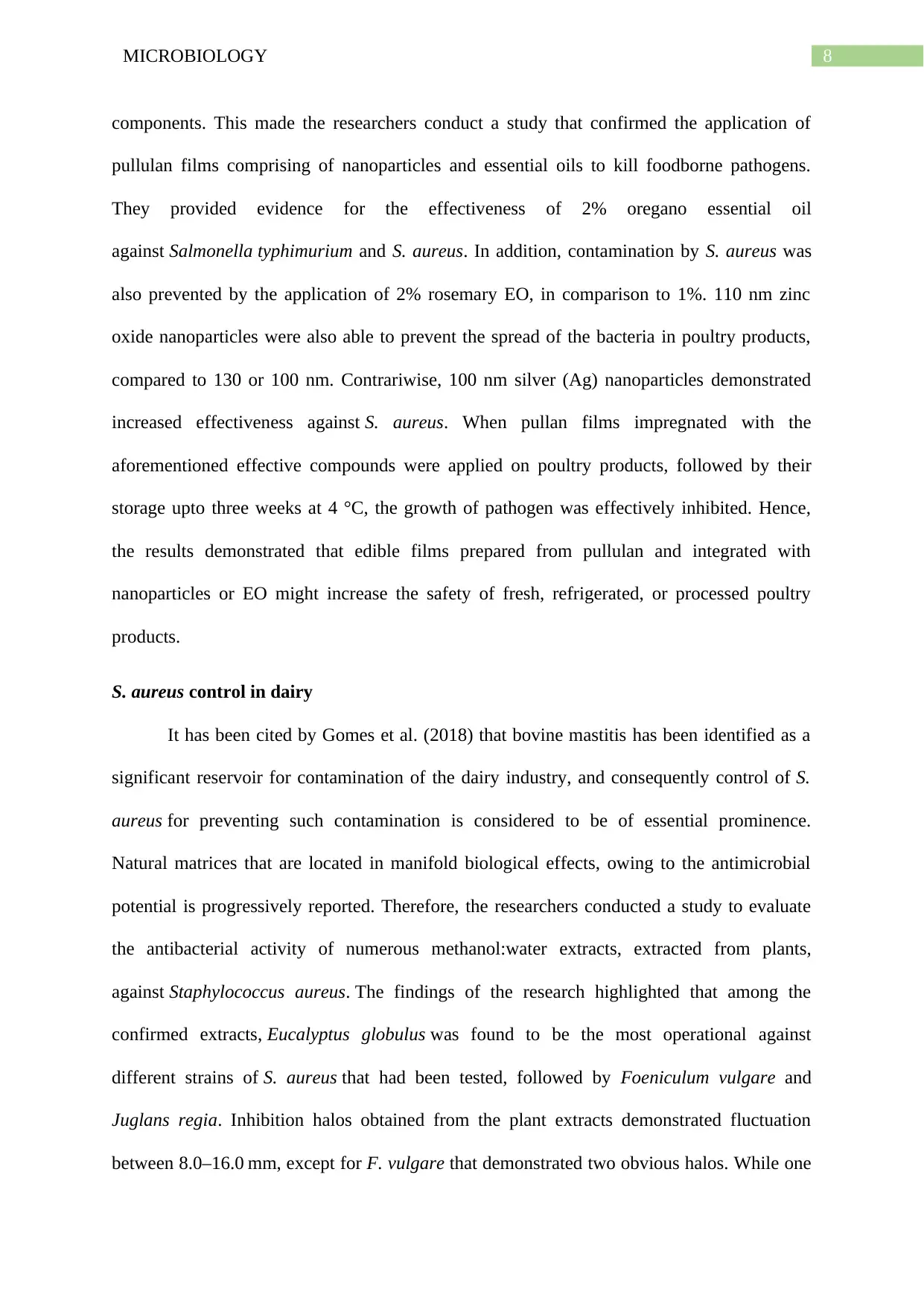
8MICROBIOLOGY
components. This made the researchers conduct a study that confirmed the application of
pullulan films comprising of nanoparticles and essential oils to kill foodborne pathogens.
They provided evidence for the effectiveness of 2% oregano essential oil
against Salmonella typhimurium and S. aureus. In addition, contamination by S. aureus was
also prevented by the application of 2% rosemary EO, in comparison to 1%. 110 nm zinc
oxide nanoparticles were also able to prevent the spread of the bacteria in poultry products,
compared to 130 or 100 nm. Contrariwise, 100 nm silver (Ag) nanoparticles demonstrated
increased effectiveness against S. aureus. When pullan films impregnated with the
aforementioned effective compounds were applied on poultry products, followed by their
storage upto three weeks at 4 °C, the growth of pathogen was effectively inhibited. Hence,
the results demonstrated that edible films prepared from pullulan and integrated with
nanoparticles or EO might increase the safety of fresh, refrigerated, or processed poultry
products.
S. aureus control in dairy
It has been cited by Gomes et al. (2018) that bovine mastitis has been identified as a
significant reservoir for contamination of the dairy industry, and consequently control of S.
aureus for preventing such contamination is considered to be of essential prominence.
Natural matrices that are located in manifold biological effects, owing to the antimicrobial
potential is progressively reported. Therefore, the researchers conducted a study to evaluate
the antibacterial activity of numerous methanol:water extracts, extracted from plants,
against Staphylococcus aureus. The findings of the research highlighted that among the
confirmed extracts, Eucalyptus globulus was found to be the most operational against
different strains of S. aureus that had been tested, followed by Foeniculum vulgare and
Juglans regia. Inhibition halos obtained from the plant extracts demonstrated fluctuation
between 8.0–16.0 mm, except for F. vulgare that demonstrated two obvious halos. While one
components. This made the researchers conduct a study that confirmed the application of
pullulan films comprising of nanoparticles and essential oils to kill foodborne pathogens.
They provided evidence for the effectiveness of 2% oregano essential oil
against Salmonella typhimurium and S. aureus. In addition, contamination by S. aureus was
also prevented by the application of 2% rosemary EO, in comparison to 1%. 110 nm zinc
oxide nanoparticles were also able to prevent the spread of the bacteria in poultry products,
compared to 130 or 100 nm. Contrariwise, 100 nm silver (Ag) nanoparticles demonstrated
increased effectiveness against S. aureus. When pullan films impregnated with the
aforementioned effective compounds were applied on poultry products, followed by their
storage upto three weeks at 4 °C, the growth of pathogen was effectively inhibited. Hence,
the results demonstrated that edible films prepared from pullulan and integrated with
nanoparticles or EO might increase the safety of fresh, refrigerated, or processed poultry
products.
S. aureus control in dairy
It has been cited by Gomes et al. (2018) that bovine mastitis has been identified as a
significant reservoir for contamination of the dairy industry, and consequently control of S.
aureus for preventing such contamination is considered to be of essential prominence.
Natural matrices that are located in manifold biological effects, owing to the antimicrobial
potential is progressively reported. Therefore, the researchers conducted a study to evaluate
the antibacterial activity of numerous methanol:water extracts, extracted from plants,
against Staphylococcus aureus. The findings of the research highlighted that among the
confirmed extracts, Eucalyptus globulus was found to be the most operational against
different strains of S. aureus that had been tested, followed by Foeniculum vulgare and
Juglans regia. Inhibition halos obtained from the plant extracts demonstrated fluctuation
between 8.0–16.0 mm, except for F. vulgare that demonstrated two obvious halos. While one
⊘ This is a preview!⊘
Do you want full access?
Subscribe today to unlock all pages.

Trusted by 1+ million students worldwide
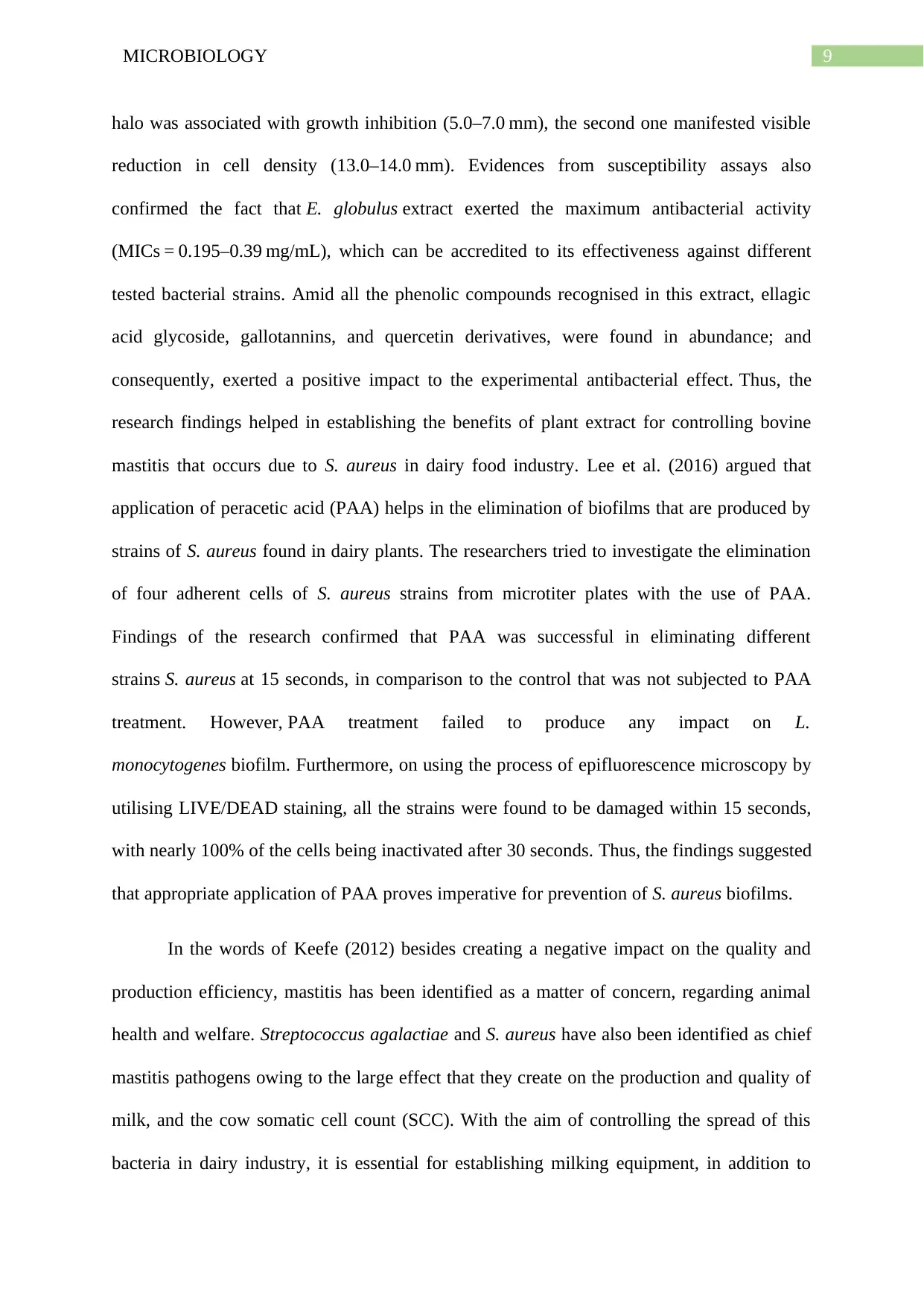
9MICROBIOLOGY
halo was associated with growth inhibition (5.0–7.0 mm), the second one manifested visible
reduction in cell density (13.0–14.0 mm). Evidences from susceptibility assays also
confirmed the fact that E. globulus extract exerted the maximum antibacterial activity
(MICs = 0.195–0.39 mg/mL), which can be accredited to its effectiveness against different
tested bacterial strains. Amid all the phenolic compounds recognised in this extract, ellagic
acid glycoside, gallotannins, and quercetin derivatives, were found in abundance; and
consequently, exerted a positive impact to the experimental antibacterial effect. Thus, the
research findings helped in establishing the benefits of plant extract for controlling bovine
mastitis that occurs due to S. aureus in dairy food industry. Lee et al. (2016) argued that
application of peracetic acid (PAA) helps in the elimination of biofilms that are produced by
strains of S. aureus found in dairy plants. The researchers tried to investigate the elimination
of four adherent cells of S. aureus strains from microtiter plates with the use of PAA.
Findings of the research confirmed that PAA was successful in eliminating different
strains S. aureus at 15 seconds, in comparison to the control that was not subjected to PAA
treatment. However, PAA treatment failed to produce any impact on L.
monocytogenes biofilm. Furthermore, on using the process of epifluorescence microscopy by
utilising LIVE/DEAD staining, all the strains were found to be damaged within 15 seconds,
with nearly 100% of the cells being inactivated after 30 seconds. Thus, the findings suggested
that appropriate application of PAA proves imperative for prevention of S. aureus biofilms.
In the words of Keefe (2012) besides creating a negative impact on the quality and
production efficiency, mastitis has been identified as a matter of concern, regarding animal
health and welfare. Streptococcus agalactiae and S. aureus have also been identified as chief
mastitis pathogens owing to the large effect that they create on the production and quality of
milk, and the cow somatic cell count (SCC). With the aim of controlling the spread of this
bacteria in dairy industry, it is essential for establishing milking equipment, in addition to
halo was associated with growth inhibition (5.0–7.0 mm), the second one manifested visible
reduction in cell density (13.0–14.0 mm). Evidences from susceptibility assays also
confirmed the fact that E. globulus extract exerted the maximum antibacterial activity
(MICs = 0.195–0.39 mg/mL), which can be accredited to its effectiveness against different
tested bacterial strains. Amid all the phenolic compounds recognised in this extract, ellagic
acid glycoside, gallotannins, and quercetin derivatives, were found in abundance; and
consequently, exerted a positive impact to the experimental antibacterial effect. Thus, the
research findings helped in establishing the benefits of plant extract for controlling bovine
mastitis that occurs due to S. aureus in dairy food industry. Lee et al. (2016) argued that
application of peracetic acid (PAA) helps in the elimination of biofilms that are produced by
strains of S. aureus found in dairy plants. The researchers tried to investigate the elimination
of four adherent cells of S. aureus strains from microtiter plates with the use of PAA.
Findings of the research confirmed that PAA was successful in eliminating different
strains S. aureus at 15 seconds, in comparison to the control that was not subjected to PAA
treatment. However, PAA treatment failed to produce any impact on L.
monocytogenes biofilm. Furthermore, on using the process of epifluorescence microscopy by
utilising LIVE/DEAD staining, all the strains were found to be damaged within 15 seconds,
with nearly 100% of the cells being inactivated after 30 seconds. Thus, the findings suggested
that appropriate application of PAA proves imperative for prevention of S. aureus biofilms.
In the words of Keefe (2012) besides creating a negative impact on the quality and
production efficiency, mastitis has been identified as a matter of concern, regarding animal
health and welfare. Streptococcus agalactiae and S. aureus have also been identified as chief
mastitis pathogens owing to the large effect that they create on the production and quality of
milk, and the cow somatic cell count (SCC). With the aim of controlling the spread of this
bacteria in dairy industry, it is essential for establishing milking equipment, in addition to
Paraphrase This Document
Need a fresh take? Get an instant paraphrase of this document with our AI Paraphraser
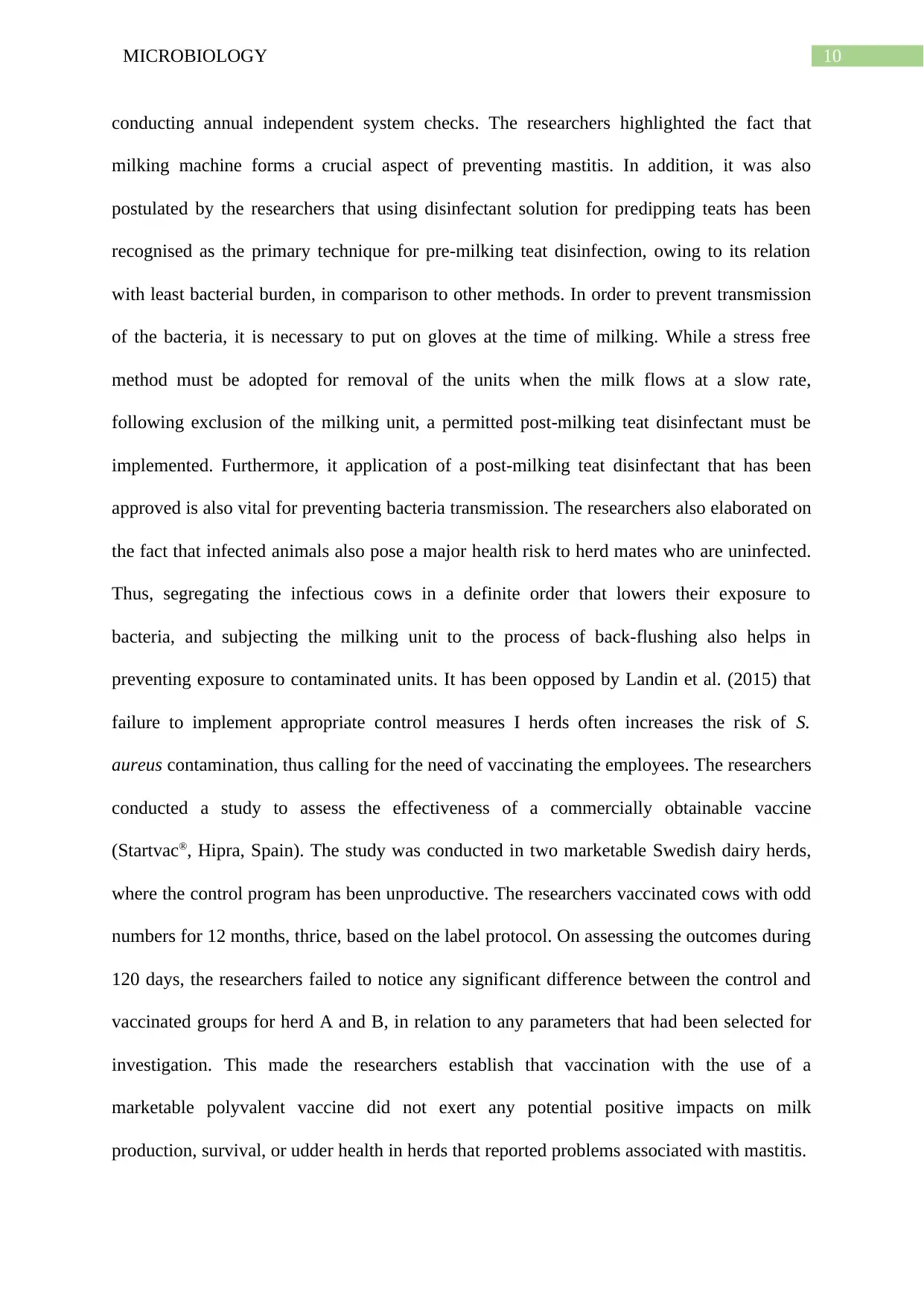
10MICROBIOLOGY
conducting annual independent system checks. The researchers highlighted the fact that
milking machine forms a crucial aspect of preventing mastitis. In addition, it was also
postulated by the researchers that using disinfectant solution for predipping teats has been
recognised as the primary technique for pre-milking teat disinfection, owing to its relation
with least bacterial burden, in comparison to other methods. In order to prevent transmission
of the bacteria, it is necessary to put on gloves at the time of milking. While a stress free
method must be adopted for removal of the units when the milk flows at a slow rate,
following exclusion of the milking unit, a permitted post-milking teat disinfectant must be
implemented. Furthermore, it application of a post-milking teat disinfectant that has been
approved is also vital for preventing bacteria transmission. The researchers also elaborated on
the fact that infected animals also pose a major health risk to herd mates who are uninfected.
Thus, segregating the infectious cows in a definite order that lowers their exposure to
bacteria, and subjecting the milking unit to the process of back-flushing also helps in
preventing exposure to contaminated units. It has been opposed by Landin et al. (2015) that
failure to implement appropriate control measures I herds often increases the risk of S.
aureus contamination, thus calling for the need of vaccinating the employees. The researchers
conducted a study to assess the effectiveness of a commercially obtainable vaccine
(Startvac®, Hipra, Spain). The study was conducted in two marketable Swedish dairy herds,
where the control program has been unproductive. The researchers vaccinated cows with odd
numbers for 12 months, thrice, based on the label protocol. On assessing the outcomes during
120 days, the researchers failed to notice any significant difference between the control and
vaccinated groups for herd A and B, in relation to any parameters that had been selected for
investigation. This made the researchers establish that vaccination with the use of a
marketable polyvalent vaccine did not exert any potential positive impacts on milk
production, survival, or udder health in herds that reported problems associated with mastitis.
conducting annual independent system checks. The researchers highlighted the fact that
milking machine forms a crucial aspect of preventing mastitis. In addition, it was also
postulated by the researchers that using disinfectant solution for predipping teats has been
recognised as the primary technique for pre-milking teat disinfection, owing to its relation
with least bacterial burden, in comparison to other methods. In order to prevent transmission
of the bacteria, it is necessary to put on gloves at the time of milking. While a stress free
method must be adopted for removal of the units when the milk flows at a slow rate,
following exclusion of the milking unit, a permitted post-milking teat disinfectant must be
implemented. Furthermore, it application of a post-milking teat disinfectant that has been
approved is also vital for preventing bacteria transmission. The researchers also elaborated on
the fact that infected animals also pose a major health risk to herd mates who are uninfected.
Thus, segregating the infectious cows in a definite order that lowers their exposure to
bacteria, and subjecting the milking unit to the process of back-flushing also helps in
preventing exposure to contaminated units. It has been opposed by Landin et al. (2015) that
failure to implement appropriate control measures I herds often increases the risk of S.
aureus contamination, thus calling for the need of vaccinating the employees. The researchers
conducted a study to assess the effectiveness of a commercially obtainable vaccine
(Startvac®, Hipra, Spain). The study was conducted in two marketable Swedish dairy herds,
where the control program has been unproductive. The researchers vaccinated cows with odd
numbers for 12 months, thrice, based on the label protocol. On assessing the outcomes during
120 days, the researchers failed to notice any significant difference between the control and
vaccinated groups for herd A and B, in relation to any parameters that had been selected for
investigation. This made the researchers establish that vaccination with the use of a
marketable polyvalent vaccine did not exert any potential positive impacts on milk
production, survival, or udder health in herds that reported problems associated with mastitis.
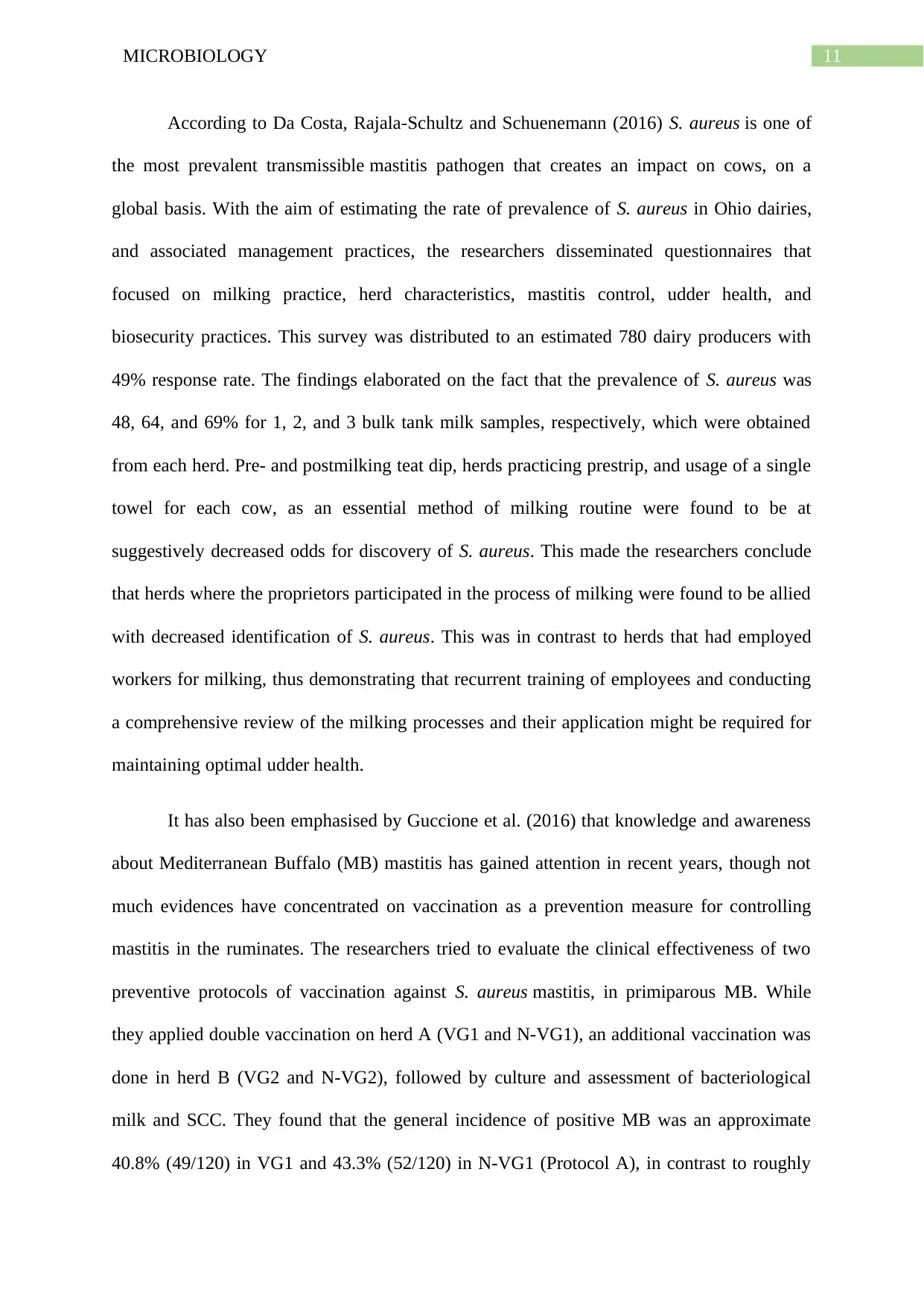
11MICROBIOLOGY
According to Da Costa, Rajala-Schultz and Schuenemann (2016) S. aureus is one of
the most prevalent transmissible mastitis pathogen that creates an impact on cows, on a
global basis. With the aim of estimating the rate of prevalence of S. aureus in Ohio dairies,
and associated management practices, the researchers disseminated questionnaires that
focused on milking practice, herd characteristics, mastitis control, udder health, and
biosecurity practices. This survey was distributed to an estimated 780 dairy producers with
49% response rate. The findings elaborated on the fact that the prevalence of S. aureus was
48, 64, and 69% for 1, 2, and 3 bulk tank milk samples, respectively, which were obtained
from each herd. Pre- and postmilking teat dip, herds practicing prestrip, and usage of a single
towel for each cow, as an essential method of milking routine were found to be at
suggestively decreased odds for discovery of S. aureus. This made the researchers conclude
that herds where the proprietors participated in the process of milking were found to be allied
with decreased identification of S. aureus. This was in contrast to herds that had employed
workers for milking, thus demonstrating that recurrent training of employees and conducting
a comprehensive review of the milking processes and their application might be required for
maintaining optimal udder health.
It has also been emphasised by Guccione et al. (2016) that knowledge and awareness
about Mediterranean Buffalo (MB) mastitis has gained attention in recent years, though not
much evidences have concentrated on vaccination as a prevention measure for controlling
mastitis in the ruminates. The researchers tried to evaluate the clinical effectiveness of two
preventive protocols of vaccination against S. aureus mastitis, in primiparous MB. While
they applied double vaccination on herd A (VG1 and N-VG1), an additional vaccination was
done in herd B (VG2 and N-VG2), followed by culture and assessment of bacteriological
milk and SCC. They found that the general incidence of positive MB was an approximate
40.8% (49/120) in VG1 and 43.3% (52/120) in N-VG1 (Protocol A), in contrast to roughly
According to Da Costa, Rajala-Schultz and Schuenemann (2016) S. aureus is one of
the most prevalent transmissible mastitis pathogen that creates an impact on cows, on a
global basis. With the aim of estimating the rate of prevalence of S. aureus in Ohio dairies,
and associated management practices, the researchers disseminated questionnaires that
focused on milking practice, herd characteristics, mastitis control, udder health, and
biosecurity practices. This survey was distributed to an estimated 780 dairy producers with
49% response rate. The findings elaborated on the fact that the prevalence of S. aureus was
48, 64, and 69% for 1, 2, and 3 bulk tank milk samples, respectively, which were obtained
from each herd. Pre- and postmilking teat dip, herds practicing prestrip, and usage of a single
towel for each cow, as an essential method of milking routine were found to be at
suggestively decreased odds for discovery of S. aureus. This made the researchers conclude
that herds where the proprietors participated in the process of milking were found to be allied
with decreased identification of S. aureus. This was in contrast to herds that had employed
workers for milking, thus demonstrating that recurrent training of employees and conducting
a comprehensive review of the milking processes and their application might be required for
maintaining optimal udder health.
It has also been emphasised by Guccione et al. (2016) that knowledge and awareness
about Mediterranean Buffalo (MB) mastitis has gained attention in recent years, though not
much evidences have concentrated on vaccination as a prevention measure for controlling
mastitis in the ruminates. The researchers tried to evaluate the clinical effectiveness of two
preventive protocols of vaccination against S. aureus mastitis, in primiparous MB. While
they applied double vaccination on herd A (VG1 and N-VG1), an additional vaccination was
done in herd B (VG2 and N-VG2), followed by culture and assessment of bacteriological
milk and SCC. They found that the general incidence of positive MB was an approximate
40.8% (49/120) in VG1 and 43.3% (52/120) in N-VG1 (Protocol A), in contrast to roughly
⊘ This is a preview!⊘
Do you want full access?
Subscribe today to unlock all pages.

Trusted by 1+ million students worldwide
1 out of 18
Your All-in-One AI-Powered Toolkit for Academic Success.
+13062052269
info@desklib.com
Available 24*7 on WhatsApp / Email
![[object Object]](/_next/static/media/star-bottom.7253800d.svg)
Unlock your academic potential
Copyright © 2020–2025 A2Z Services. All Rights Reserved. Developed and managed by ZUCOL.

